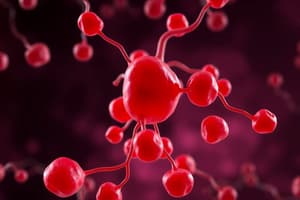Podcast
Questions and Answers
Fatty Acid Synthesis occurs in the cell ______.
Fatty Acid Synthesis occurs in the cell ______.
cytoplasm
The inner mitochondrial membrane is impermeable to ______-CoA.
The inner mitochondrial membrane is impermeable to ______-CoA.
Acetyl
The tricarboxylate transporter moves Acetyl-CoA out of mitochondria as ______.
The tricarboxylate transporter moves Acetyl-CoA out of mitochondria as ______.
citrate
The first step in fatty acid synthesis starts with two ______-CoA.
The first step in fatty acid synthesis starts with two ______-CoA.
The enzyme that catalyzes the conversion of acetyl-CoA to malonyl-ACP is called ______.
The enzyme that catalyzes the conversion of acetyl-CoA to malonyl-ACP is called ______.
The addition of malonyl-ACP to the growing chain ultimately produces a ______ chain.
The addition of malonyl-ACP to the growing chain ultimately produces a ______ chain.
The regulatory enzyme of fatty acid synthesis is primarily ______.
The regulatory enzyme of fatty acid synthesis is primarily ______.
The acyl-carrier protein is essential for forming ______-CoA.
The acyl-carrier protein is essential for forming ______-CoA.
The breakdown of fat in adipocytes requires catalytic action of three enzymes, among which is the hormone sensitive triacylglycerol lipase, also known as ______.
The breakdown of fat in adipocytes requires catalytic action of three enzymes, among which is the hormone sensitive triacylglycerol lipase, also known as ______.
Synthesis of fat starting with glycerol-3-phosphate requires the action of acyl transferase enzymes such as glycerol-3-phosphate acyl ______.
Synthesis of fat starting with glycerol-3-phosphate requires the action of acyl transferase enzymes such as glycerol-3-phosphate acyl ______.
In fatty acid synthesis, the addition of another ______ product of malonyl-CoA leads to the formation of longer fatty acids.
In fatty acid synthesis, the addition of another ______ product of malonyl-CoA leads to the formation of longer fatty acids.
Phosphatidic acid is an intermediate in the synthesis of both fats and ______.
Phosphatidic acid is an intermediate in the synthesis of both fats and ______.
The primary control of fatty acid oxidation is the ______.
The primary control of fatty acid oxidation is the ______.
Only LIPE is regulated and it appears to be the ______ limiting reaction in fat metabolism.
Only LIPE is regulated and it appears to be the ______ limiting reaction in fat metabolism.
Glycerol-3-phosphate is esterified at position 1 with a fatty acid, followed by a duplicate reaction at position ______ to make phosphatidic acid.
Glycerol-3-phosphate is esterified at position 1 with a fatty acid, followed by a duplicate reaction at position ______ to make phosphatidic acid.
Diglyceride lipase is responsible for removing the ______ fatty acid from the fat.
Diglyceride lipase is responsible for removing the ______ fatty acid from the fat.
Beta-oxidation is the catabolic process by which fatty acid molecules are broken down in the cytosol in prokaryotes and in the ______ in eukaryotes.
Beta-oxidation is the catabolic process by which fatty acid molecules are broken down in the cytosol in prokaryotes and in the ______ in eukaryotes.
The overall reaction for one cycle of beta-oxidation involves the conversion of Cn-acyl-CoA to ______, NADH, and FADH2.
The overall reaction for one cycle of beta-oxidation involves the conversion of Cn-acyl-CoA to ______, NADH, and FADH2.
Alpha-oxidation is defined as the oxidation of fatty acid with the removal of one carbon unit adjacent to the ______ carbon.
Alpha-oxidation is defined as the oxidation of fatty acid with the removal of one carbon unit adjacent to the ______ carbon.
Free fatty acids must cross the cell membrane through specific transport proteins, such as the ______ family fatty acid transport protein.
Free fatty acids must cross the cell membrane through specific transport proteins, such as the ______ family fatty acid transport protein.
Beta-oxidation primarily takes place in the ______ membrane of mitochondria.
Beta-oxidation primarily takes place in the ______ membrane of mitochondria.
The carbon unit removed during alpha-oxidation is released in the form of ______.
The carbon unit removed during alpha-oxidation is released in the form of ______.
There is no production of ______ during alpha-oxidation.
There is no production of ______ during alpha-oxidation.
Epinephrine stimulates the ______ kinase cascade which regulates the process of fatty acid metabolism.
Epinephrine stimulates the ______ kinase cascade which regulates the process of fatty acid metabolism.
Flashcards are hidden until you start studying
Study Notes
Fatty Acid Metabolism
- Fatty acid synthesis occurs in the cytoplasm of cells.
- Acetyl-CoA is converted to citrate for transport out of mitochondria due to impermeable inner mitochondrial membrane.
- Citrate is then converted back to Acetyl-CoA in the cytoplasm for fatty acid synthesis.
Fatty Acid Synthesis
- Synthesis begins with two molecules of Acetyl-CoA, where one is converted to malonyl-CoA.
- The process involves a series of enzymatic reactions including water removal and carboxylation.
- Acetyl-CoA carboxylase (ACC) plays a key regulatory role in the synthesis.
- The growing fatty acid chain is formed by repeated cycles involving malonyl-ACP, ultimately producing palmitoyl-CoA (a 16-carbon molecule).
Metabolism of Fat
- Fat synthesis utilizes glycerol-3-phosphate and three fatty acids.
- Glycerol-3-phosphate is esterified at specific positions to form intermediates including phosphatidic acid and diacylglycerol.
- Breakdown of fats in adipocytes is catalyzed by three enzymes: hormone-sensitive triacylglycerol lipase (LIPE), diglyceride lipase, and monoglyceride lipase.
- LIPE is rate-limiting and primarily regulated; available fatty acids control oxidation rates.
Fatty Acid Beta-Oxidation
- Beta-oxidation is the catabolic process of fatty acid degradation in eukaryotic mitochondria and prokaryotic cytosol, producing acetyl-CoA, NADH, and FADH2.
- The process is named for the oxidation occurring at the beta carbon of fatty acids.
- The mitochondrial trifunctional protein complex is critical for facilitating this process.
- The reaction converts Cn-acyl-CoA into shorter-chain acyl-CoA and releases acetyl-CoA, NADH, and FADH2.
Fatty Acid Alpha-Oxidation
- Alpha-oxidation involves the removal of a carbon unit adjacent to the alpha-carbon, particularly for fatty acids with a methyl group at the beta-carbon.
- This process occurs when beta-oxidation is blocked and does not produce ATP.
Membrane Transport
- Free fatty acids can't cross biological membranes due to their negative charge.
- Transport proteins, specifically from the SLC27 family, are essential for fatty acid transport into cells.
- Following entry, fatty acids are transported into the mitochondrial matrix for beta-oxidation.
Studying That Suits You
Use AI to generate personalized quizzes and flashcards to suit your learning preferences.




